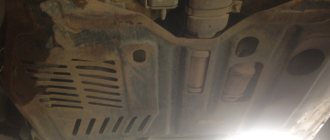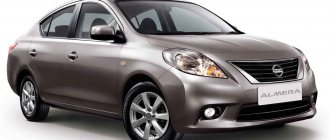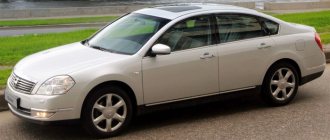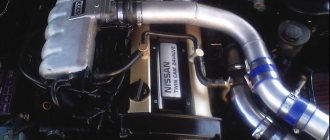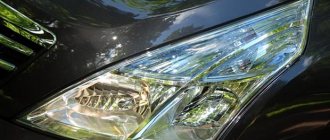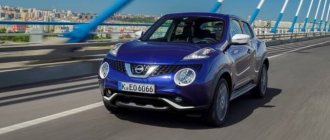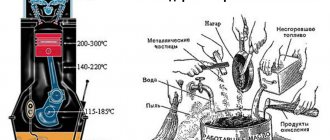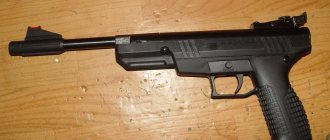Starting in 2000, for 13 years , the Nissan QR20DE engine was installed on mid-size Nissan models such as Serena, Xtrail, Primera and others that fit these characteristics.
It is not surprising that this engine, one of the four QR series, is quite well known to auto mechanics in almost all countries of the world.
QR20DE engine characteristics
QR20DE engine
The QR20DE engine has the following technical characteristics :
- years when the internal combustion engine was produced 2000-2013;
- exact (in cubic cm) volume 1998;
- power (in hp) 147;
- The fuel used in the internal combustion engine is 95 gasoline;
- environmental standard (class) Euro 3/4;
- number of cylinders 4;
- number of valves on one cylinder 4;
- diameter (in mm) of the cylinder 89;
- the cylinder block is made of aluminum;
- power supply system - injector;
- torque (rotational) moment (N/m) 200 at 4000 rpm;
- compression ratio 9.9;
- the frequency of replacing engine lubricant is better than 7,500, 15,000 (recommended);
- volume (in liters) of engine oil 3.9;
- permissible oil consumption (in g) 500/1000;
- stroke (in mm) of the piston 80.3;
- The engine operating temperature is about 90 degrees;
- timing drive type – chain;
The approximate resource of the internal combustion engine is not much more than 200 thousand km.
Fuel consumption QR20
- The QR20DE engine with 4 automatic transmissions and all-wheel drive (this is installed, for example, on the first generation X-Trail) consumes gasoline in the city 13.1 liters. Outside the city, on the highway this figure is 8.1, and in the combined cycle – exactly 10 liters .
Nissan X-Trail first generation (T30) - The fuel consumption of an engine with a manual transmission in this model is 9, 6.5 and 7.2 .
- But the first generation Nissan Teana with automatic transmission and front-wheel drive will consume 13.2, 8.1 and 10 liters .
- Nissan has examples of the third generation (P12) with manual transmission and front-wheel drive - 11.9, 6.9 and 8.7 l.
Nissan Primera third generation (P12)
Motor modifications
The 2.0-liter QR20DD engine was produced by Nissan from 2000 to 2005 inclusive, and was mounted on the Bluebird Sylphy sedan. The unit is demanding on fuel quality. Because of this characteristic, it is practically not found in our country.
Engine QR20DD
Has the same volume as the QR20DE, similar piston stroke and cylinder parameters (diameter, number, etc.). Characteristics :
- power – 150 “horses”.
- compression ratio – 11.
- fuel - AI-98.
- eco class - Euro 4.
Features of the lubrication system
Lubrication of rubbing mechanisms, engine parts and components is provided by a gear oil pump located in the engine sump.
The path of the lubricating fluid runs from the pump, through the oil filter, to the crank and gas distribution unit of the engine. Next, through special channels in the connecting rods, to the cylinder-piston group. The spent fluid flows down and the lubrication procedure is repeated until the engine stops. The volume of the entire oil system is 3.9 liters. Types of oil recommended by the manufacturer: 5W20, 5W30, 10W30, 10W40, 10W60.
Technical features
The QR20DE is a two-liter engine with an aluminum cylinder block and a relatively short service life. Has average technical characteristics. As a rule, even if you follow all the recommendations and drive gently, this Nissan car engine barely overcomes the 200 thousand km . Even if you change the oil even more often than required by the maintenance regulations. But there are also cases when this engine served even after a mileage of 250 thousand .
Block head
It does not have hydraulic compensators, so every time after overcoming 100,000 it is necessary to adjust the valves or wait until a characteristic knock appears, and only then go to a service station.
Phase control valve for the QR20DE engine
Let us remind you that the QR20DE replaced the popular SR20DE . It featured individual ignition coils, an electronic throttle valve, an improved cylinder head, a variable valve timing system, and added balancer shafts.
Features of the KS mechanism
In the lower, inner part of the power unit there is a crankshaft on five support journals. It is connected to the pistons using connecting rods. With the help of which the crankshaft is driven. The clearance in the connecting rod and main journals is regulated by liners, also known as plain bearings. According to the documentation, their thickness should be no more than a quarter of a millimeter.
In the middle of the crankshaft, there is a channel for the circulation of engine lubricant. Through it, oil flows to all rubbing surfaces and is supplied through similar channels inside the connecting rods to the piston pins. The gaps between the cylinders and pistons are adjusted using piston rings. When they increase, compression drops and oil consumption begins.
There is a flywheel at the rear end of the crankshaft; it functions as a connection to the clutch disc. It is necessary to pay attention to the fact that when installing an automatic transmission on a car, the flywheel is much lighter and thinner than with a manual transmission. Along the outer circumference of the flywheel, there are teeth designed to engage the crankshaft with the starter.
Service
The oil intended for the QR20 engine is ke900-90042 5w40 . An internal combustion engine needs 4.1 liters . It must be replaced once a year (or after every 15 thousand mileage). Antifreeze volume - 7.1 l .
The replacement interval for the air filter, spark plugs, and coolant is respectively:
- every two years;
- every year;
- after 6, 10 and 14 years.
Due to the lack of hydraulic compensators, valve adjustment is usually required once every 100 thousand km. The timing chain can also stretch to 120 thousand km and then it will have to be replaced.
Timing chain QR20DE
Engine tuning X Trail / Primera QR20DE
Chip tuning. Atmo tuning
In the CIS countries, the engine is a little strangled, so reflashing and knocking out the catalyst will give extra
10 hp, with cylinder head porting you can increase output to 160 hp. In general, a lot of movement and little result.
Turbine/Compressor on QR20DE / QR20DET
The most expensive and pointless way to spend your money is to install a turbine or compressor. Turbo kits based on Garrett T3 and other turbines (high price) with an intercooler are sold, buy a forged SPG with counterbores for a low compression ratio (
8), productive nozzles
440cc, high-performance fuel pump, direct-flow exhaust, cylinder head porting will give us an improvement in cylinder filling, we carry out online tuning. The result is a powerful motor.
250 hp (depending on the turbo) with a low life, considering the price of all these things, you can understand why no one turbos the QR20DE. With the compressor the situation is the same, only instead of a turbo kit you buy a compressor kit, all other modifications will not go away. Naturally, you can buy a St. Petersburg compressor RK-23-1 up to 0.5 bar and install it on a standard motor, without any changes, and it will withstand, but the increase will not be so significant, and the life of the motor will be reduced. To summarize briefly, tuning the QR20DE is a completely pointless activity, financially costly and does not bring anything useful at the end.
Source
Disadvantages and weaknesses of QR20DE
The QR20DE engine, like any other, has both weak points and vulnerabilities, as well as strengths. The disadvantages include :
- The engine is difficult to start in cold weather. As a rule, difficulties arise when the mercury column of the thermometer drops to minus 20 degrees Celsius .
- The catalyst has a relatively short service life.
- The injectors and throttle body require regular cleaning.
- Sometimes a problem arises such as oil leaking from under the valve cover.
- Possible burnt of engine oil. In this case, it is necessary to check for leaks and install oil scraper rings .
Piston with oil scraper rings
QR20DE tuning options
Replacing catalytic converters with a flame retardant and a conventional pipe can increase the power of the QR20DE engine
This Nissan engine, coming to Russia and the countries of the former CIS, is somewhat strangled in software. For this reason, removing the catalyst may add an extra 10 liters. With. There is also the possibility of porting the cylinder head, which will increase the power of the unit to 160 hp. With.
Turbocharging this installation is not advisable, as it is a pointless way to waste money. For example, turbo kits based on Garrett T3 and compressors with intercooler are expensive. Additionally, you will also have to buy a forged piston with counterbores, more efficient injectors and a fuel pump, and also order direct flow. At the output, this will give about 250 horses, but the resource of the unit will noticeably decrease.
What cars was the QR20DE installed on?
Avenir W11
Nissan QR20DE engine was installed on the following brands of cars:
- Primera P12 (from 2001 to 2007);
- Vinroad Y11 (from 2001 to 2005);
- X-Trail T30 (from 2000 to 2007);
- Serena C24 (from 2002 to 2012);
- Teana J31 (from 2003 to 2008);
- Sentra B15 (from 2000 to 2006);
- Avenir W11 (from 2002 to 2005);
- Prairie M12 (2001 to 2004).
Teana J31
List of modifications QR20DE
The engine has several main modifications, differing in the volume of the combustion chambers and other technical characteristics.
Both versions had a semi-aluminum cylinder block, twin camshaft timing system and 16 valves. The first unit was equipped with multipoint electronic injection and was installed on a large number of cars. These were budget sedans and top-class cars. The technical characteristics of the engines made it possible to use them in both small cars and heavy SUVs.
Based on the basic model, child versions were created:
The engines were periodically modernized, and not too extensive engineering alterations were carried out. As a result, the versions received different types of injection, cylinder-piston, combustion chambers and compression ratios.
Source
YD22/M9R/R9M (diesel)
In addition to the traditional gasoline fours, the X-trail engine lineup includes diesel modifications. All of them are turbocharged four-cylinder engines with a displacement of 1.6 to 2.2 liters.
The first generation crossovers were equipped with a 2.2-liter YD22DDTi diesel engine. This engine has direct fuel injection of the widely used Common Rail system or electronically controlled fuel injection pump (until 2004). Unit power 114 or 136 hp. With. and torque 314 at 2000 rpm. A vehicle of this modification has an excellent traction reserve, which makes it more convenient when used under load and on bad roads; in addition, diesel has lower fuel consumption - up to 9 liters in the city, according to the manufacturer.
Of the most common malfunctions of these motors, the most common are:
- Failure of glow plugs;
- Oil leak from intercooler;
- Loud sound at cold and high speeds;
- Loss of compression in one or more cylinders.
Diesel engine 2.2 Nissan X-trail
After the 2007 release, crossovers began to be equipped with another diesel engine, the M9R. This unit was developed jointly with Renault and is installed on some cars of this brand. The engine design includes both proven solutions familiar from earlier modifications and modern developments used in the latest generation of diesel engines.
The M9R power unit features a variable geometry turbine, a common rail high-pressure fuel supply system, multi-point injection with piezoelectric injectors, a sixteen-valve cylinder head with two camshafts and a chain drive, balancer shafts, an exhaust gas recirculation system, a catalytic converter and a particulate filter. Thanks to these features, the engine shows excellent performance in terms of power, efficiency and emissions of harmful substances.
Since 2013, the new Renault-Nissan R9M engine with a volume of 1.6 liters began to be used on the T32 X-trails. The power of this unit is 130 hp. s., torque 320 at 1750 rpm. This is the most advanced engine of this crossover. It is lighter, takes up less space, is more economical and has 20% lower emissions, while maintaining vehicle dynamics at the same level. This is facilitated by such features as a more uniform distribution of the working mixture in the cylinder, modified EGR, a start-stop system and others.
In addition to the advantages, Ixtrail diesel engines also have disadvantages, some of them are well known:
- Pickiness about fuel quality;
- Need for more attentive maintenance;
- Short service interval;
- Increased fuel requirements in winter;
- High cost of repairs.
List of car models in which it was installed
During production from 1989 to 2002, the SR20DE engine was used in several Nissan cars:
- Presea - 1990 - 1998, small sedan for the Asian market;
- Avenir – 1990 – 2001, all-wheel drive station wagon;
- Serena – 1991 – 2000, minivan;
- Bluebird – 1989 – 1998, mid-size sedan;
- R'nessa – 1997 – 2000, large station wagon;
- Prairie/– 1995 – 1997, minivan;
- Liberty – 1998 – 2000,
- Wingroad/Tsubame – 1996 – 1999, large-sized station wagon with front-wheel drive and all-wheel drive;
- Silvia – 1991 – 1996, sports coupe;
- Rasheen – 1998, crossover;
- Almera – 1996 – 1999, sedan;
- Sentra/Tsuru – 1991 – 2001, compact sedan;
- Pulsar/Sabre – 1991 – 2000, subcompact crossover;
- NX2000/NX-R/100NX – 1991 – 1996, compact coupe;
- 180SX – 1991 – 1997, liftback on S-platform;
- 200SX SE-R – 1995 – 1998, liftback on S-platform;
- X-Trail GT – mid-size crossover;
- Primera – 1990 – 2002, station wagon, liftback, sedan.
Nissan Pulsar
More about Nissan: Error P0725 - Engine Speed | Infiniti club
Taking into account the improved characteristics of the engine, the SR20DE engine was installed in the compact executive car Infiniti G20 between 1991 and 2002.
The turbocharged version of the SR20DET engine was used in Nissan cars:
- Liberty Highway Star GT4 – 230 HP s., 275 Nm;
- Avenir PNW11 GT4 – 210 hp. s., 275 Nm;
- Bluebird SSS ATTESA Limited HNU12 and HNU13 – 205 and 210 hp. s., respectively, 275 Nm;
- R'nessa NN30 GT Turbo – 200 l. s., 265 Nm;
- Pulsar GTI-R RNN14 – 230 hp, 284.4 Nm;
- Silvia S15 JDM – 250 l. s., 275 Nm;
- 200SX S14/S14A – 220 hp. s., 275 Nm;
- 180SX S13 – 205 hp. s., 275 Nm;
- Silvia S13/14/15 – 205 l. s., 275 Nm.
Nisto 270R Turbo
A subsidiary of the automaker Nissan produces the Nismo 270R sports coupe with a Turbo engine of 275 Nm of torque and a total power of 270 hp. With.


